Abstract
During the past 19 years, mortality due to burn injuries has markedly declined for children at the Boston Unit of the Shriners Burns Institute (SBI), dropping from an average of 9% of SBI admissions during 1968-1970 to an average of 1% during 1981-1986. Detailed statistical analysis using logistic regression was necessary for determining whether this decline in mortality was explained by changes in patient characteristics, such as age or burn size, which are known to strongly influence the outcome of burn injuries. This dramatic decline in mortality during the past 19 years was not the result of change in the age of the patients or their burn sizes; rather, it may be attributed to improvements in burn care. Results of this statistical analysis indicated that, for burn injury patients whose ages ranged from 11 days to 19 years, age had no demonstrable effect on survival from a burn injury. Children survived burn injuries at least as well if not better than the young adult (20-29 years of age). Also, infants (less than 1 year old) survived as well as other children (2-19 years old). Dramatic improvement in survival occurred in patients with burns covering more than 50% of the body surface area. Since 1979, mortality has been essentially eliminated for patients with burn sizes less than 70% of the total body surface area (of 296 patients with burns covering 15-69% of the total body surface area, only two patients died). During the period 1979-1986, 29 of 37 patients (78%) survived an 80% or greater total body surface area thermal injury.
Full text
PDF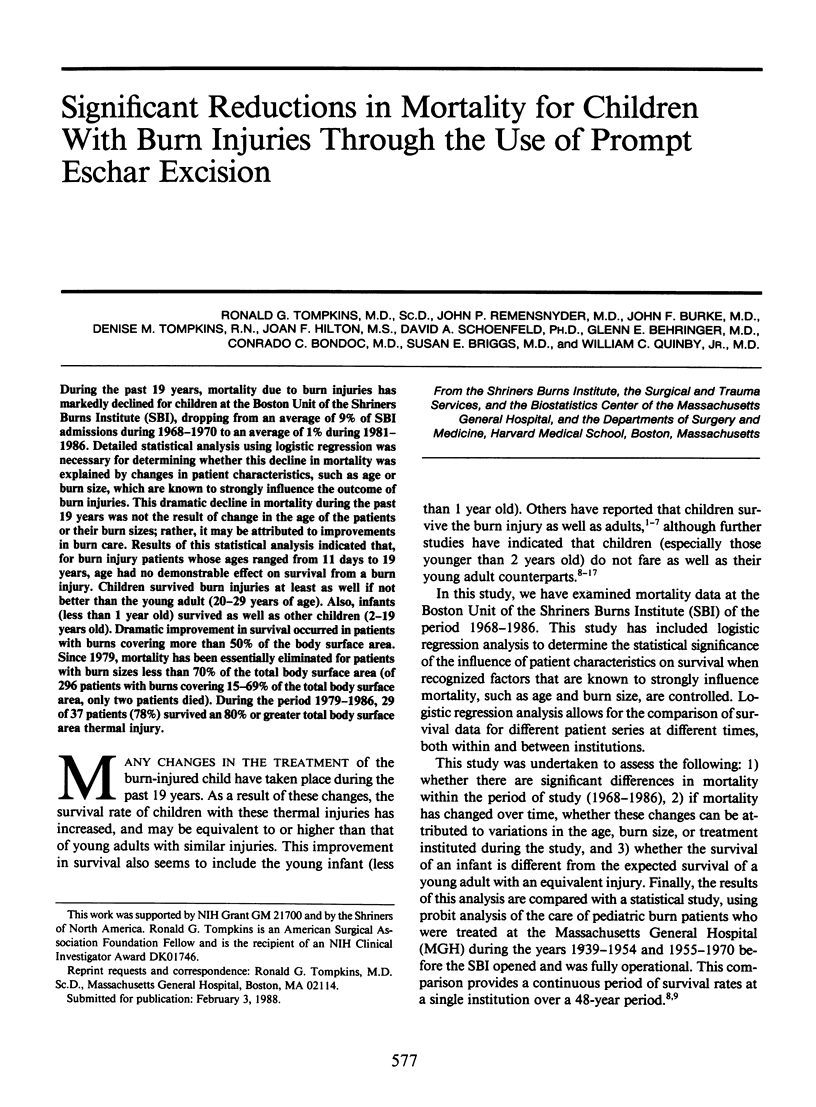
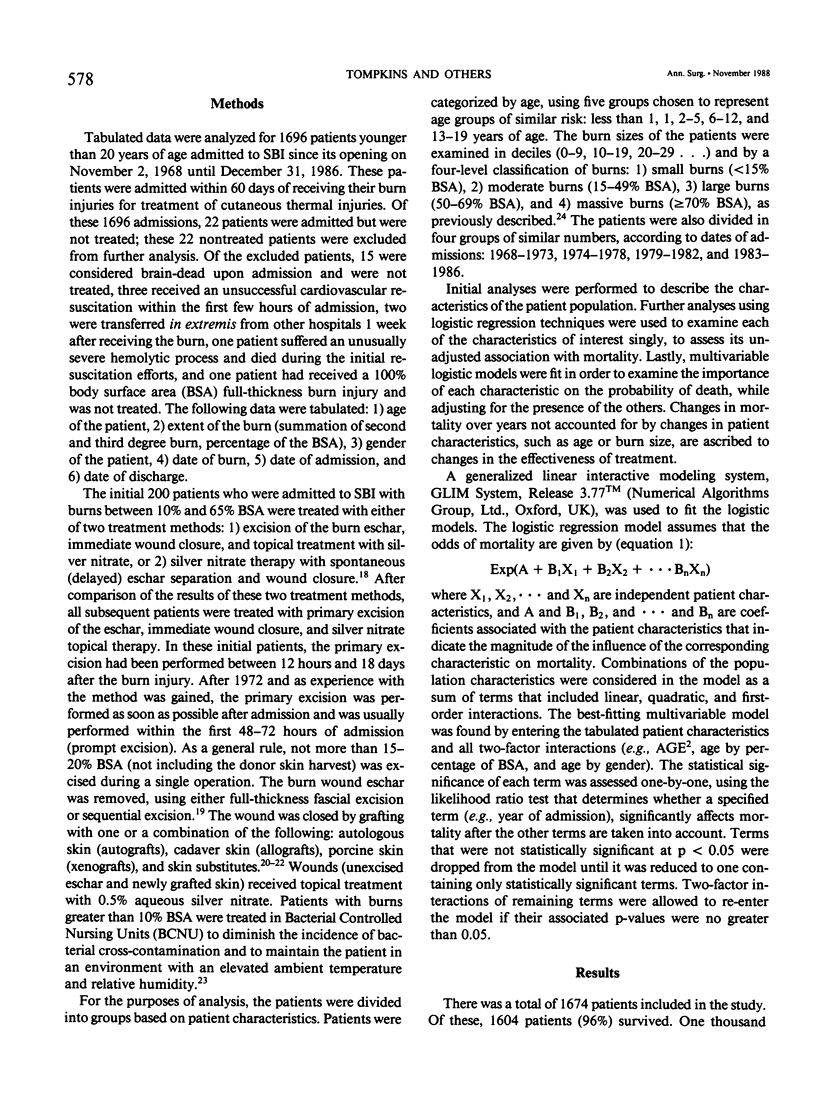
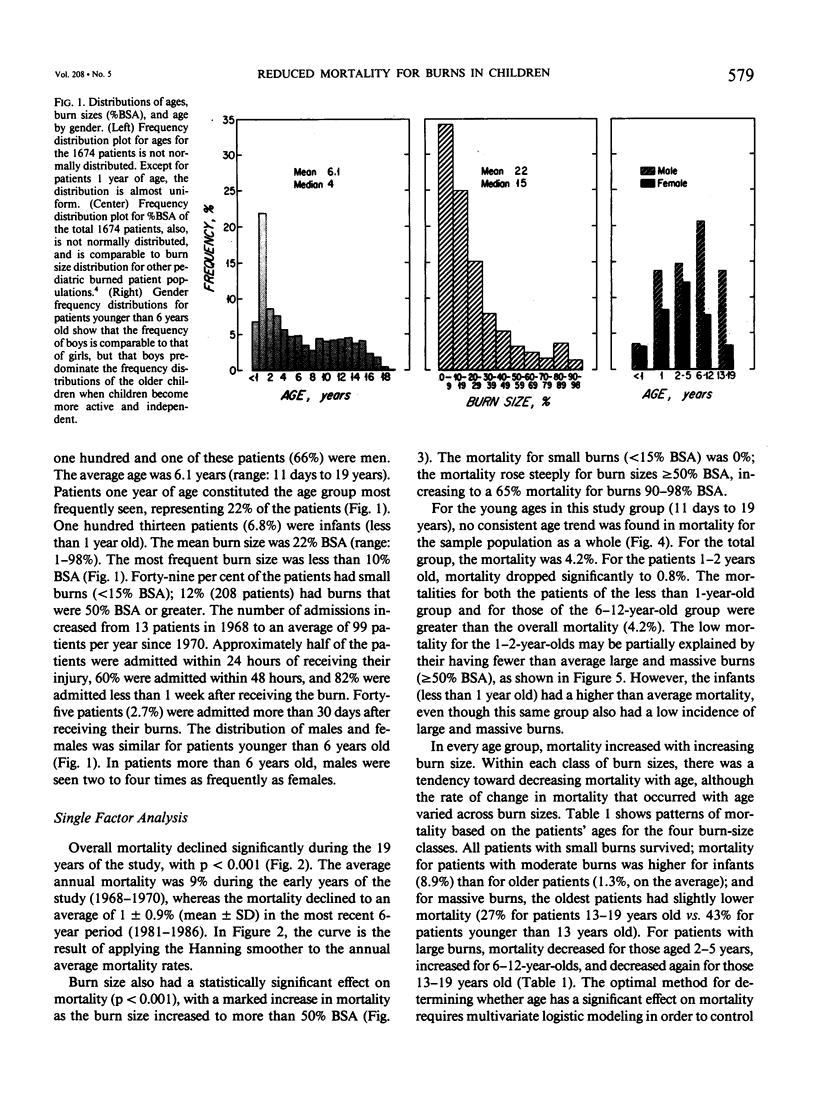
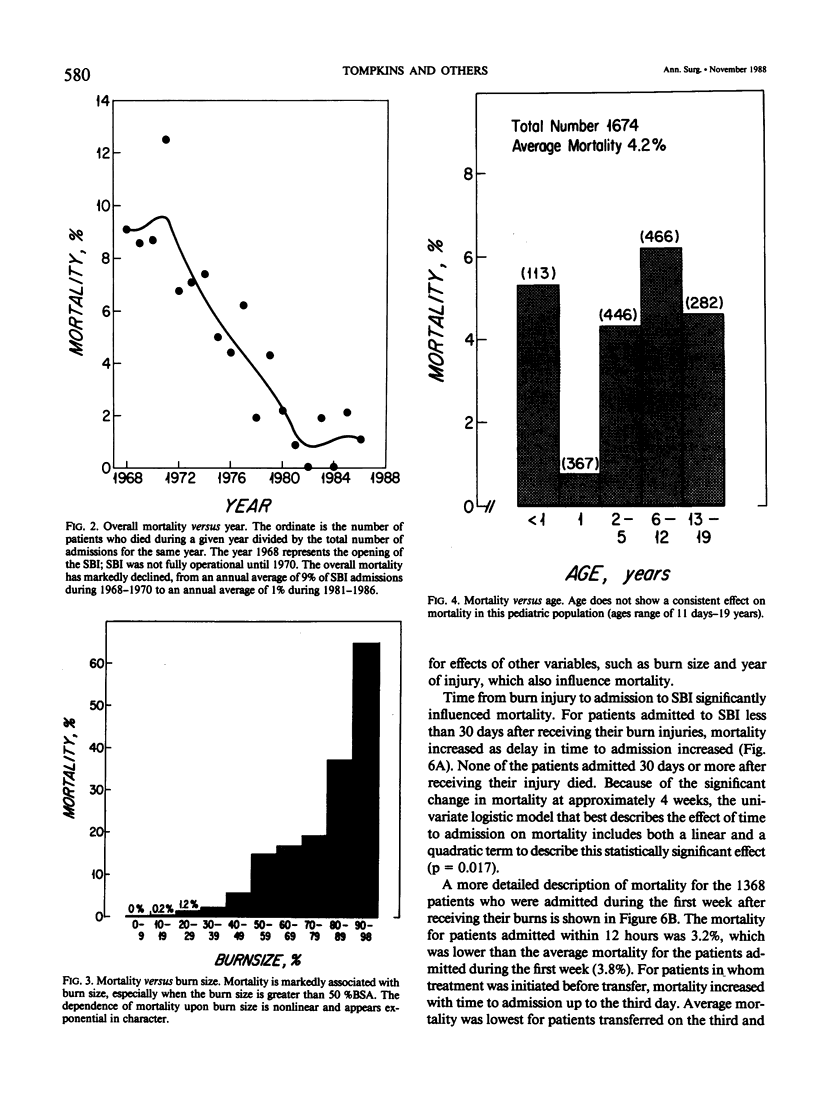
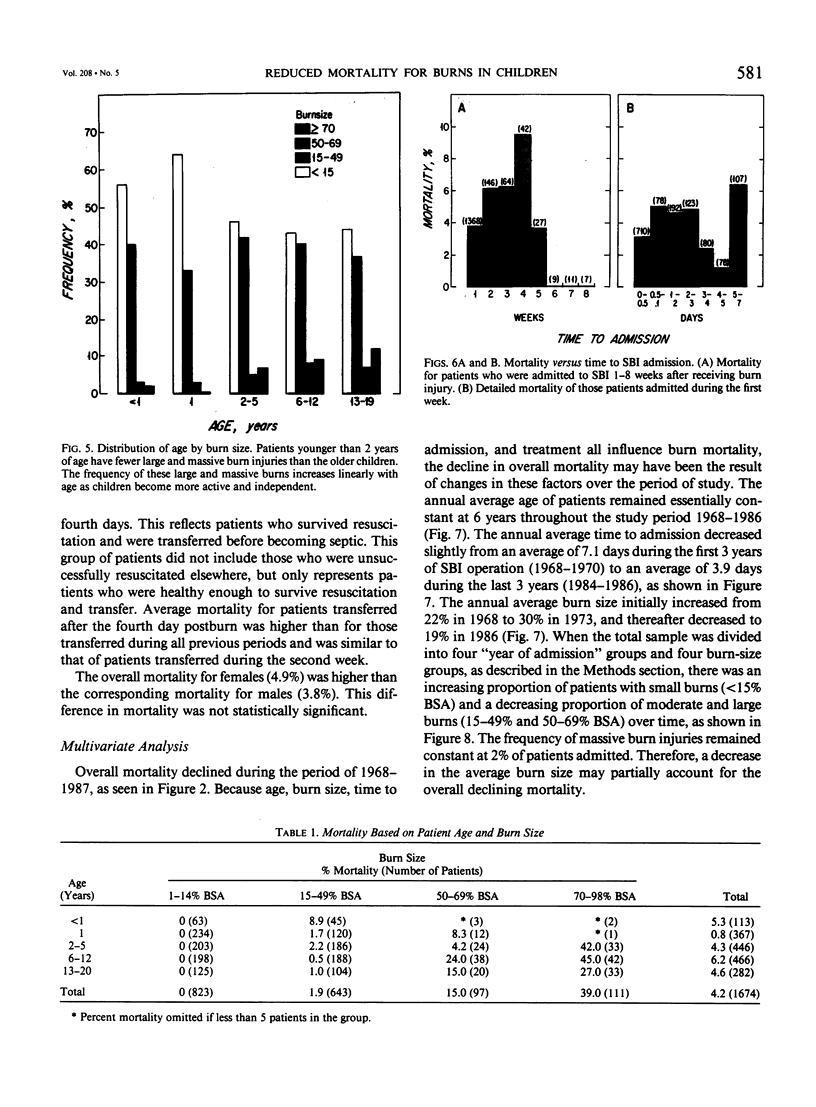
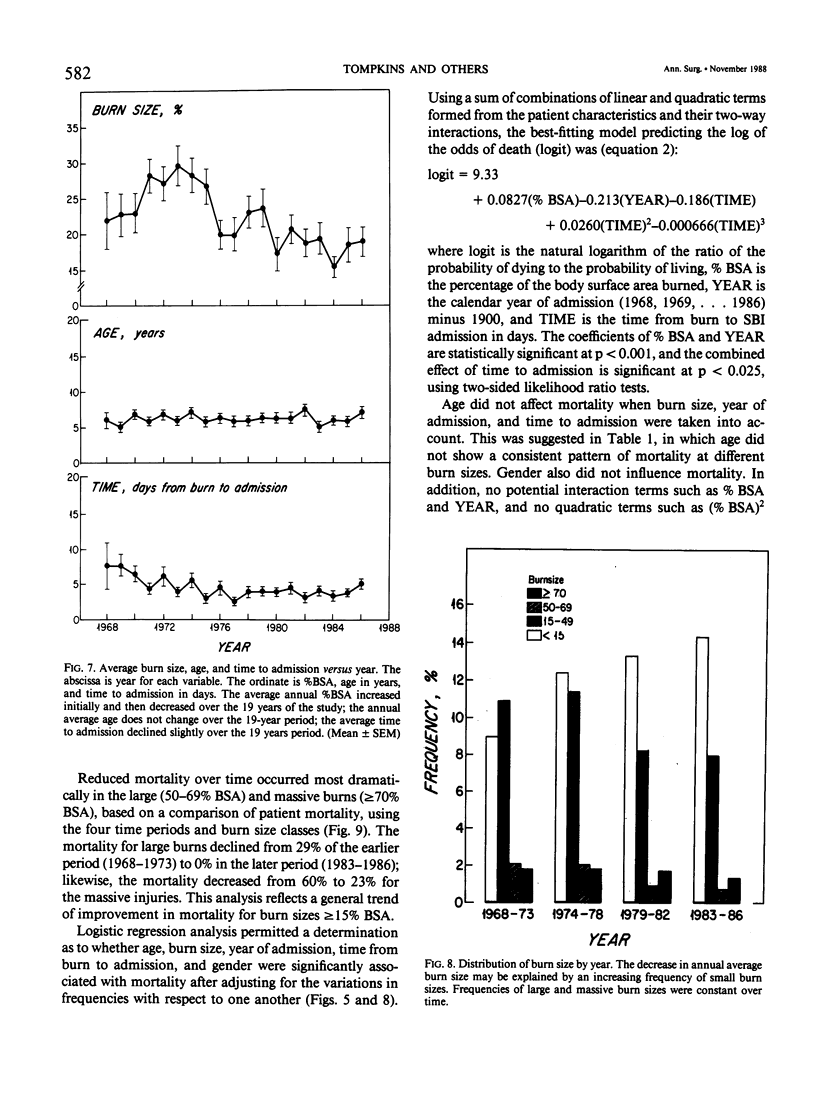

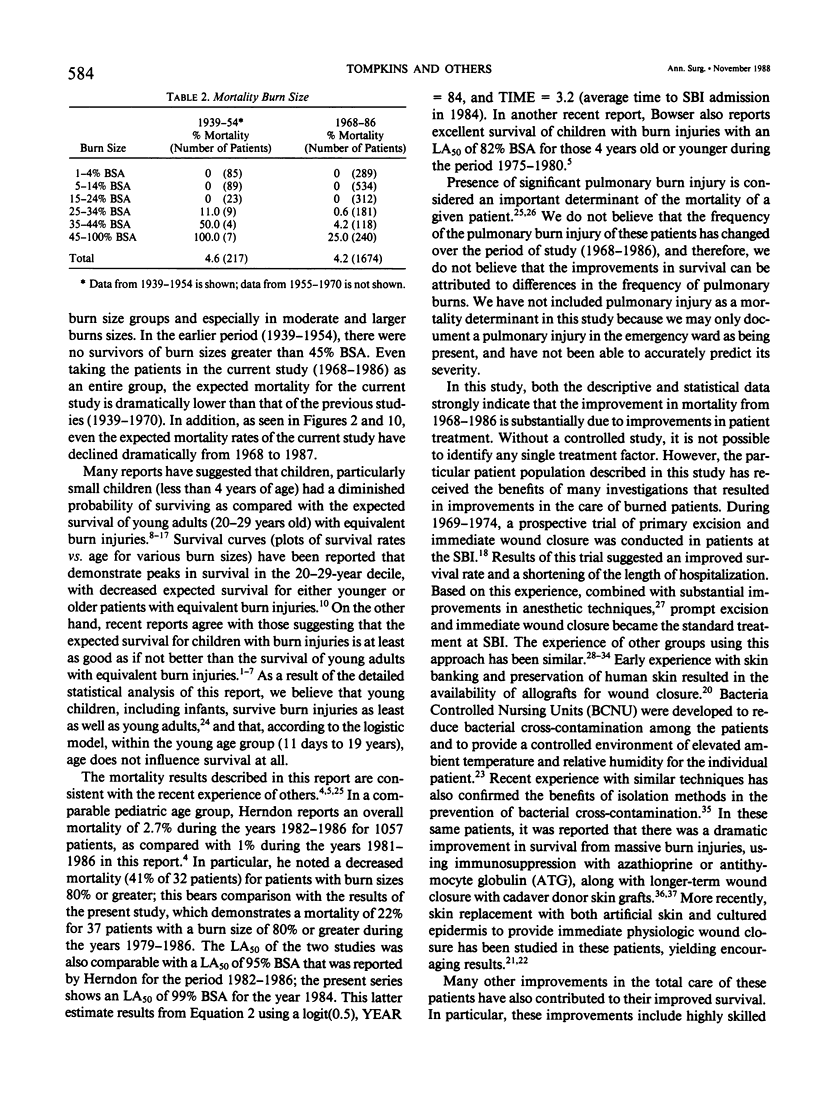
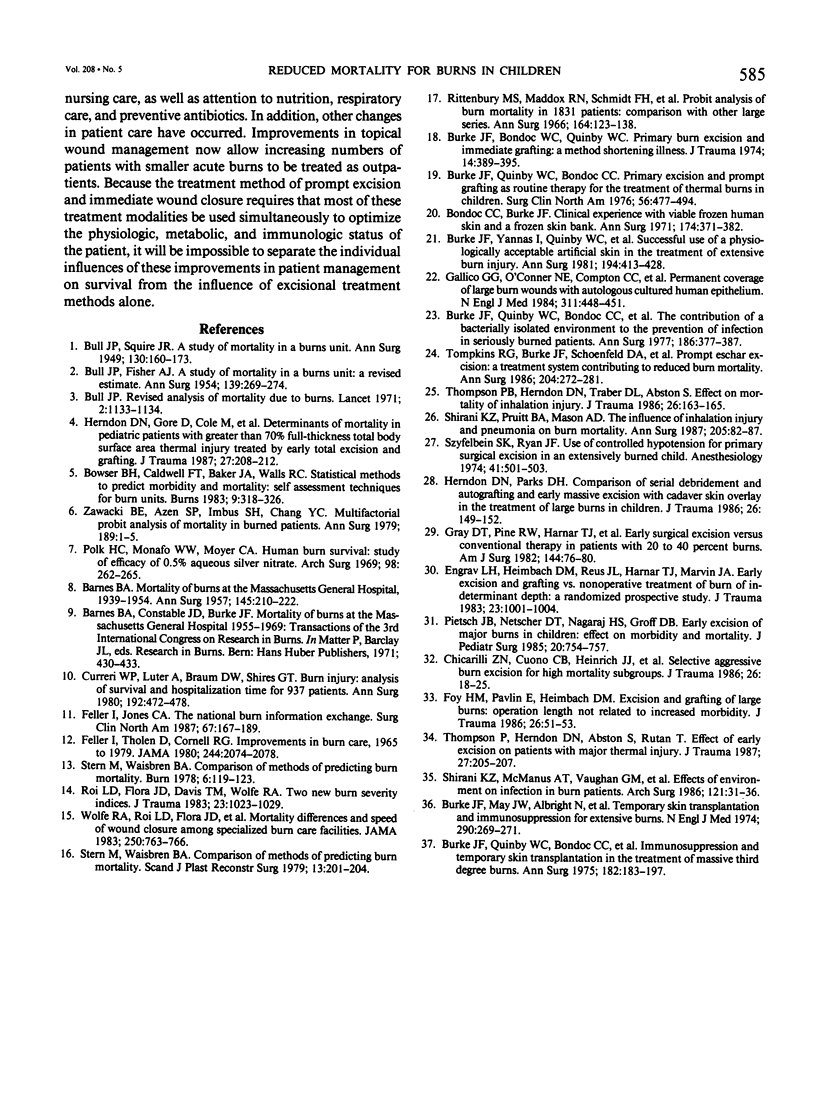
Selected References
These references are in PubMed. This may not be the complete list of references from this article.
- BARNES B. A. Mortality of burns at the Massachusetts General Hospital, 1939-1954. Ann Surg. 1957 Feb;145(2):210–222. doi: 10.1097/00000658-195702000-00010. [DOI] [PMC free article] [PubMed] [Google Scholar]
- BULL J. P., FISHER A. J. A study of mortality in a burns unit: a revised estimate. Ann Surg. 1954 Mar;139(3):269–274. doi: 10.1097/00000658-195403000-00002. [DOI] [PMC free article] [PubMed] [Google Scholar]
- Bondoc C. C., Burke J. F. Clinical experience with viable frozen human skin and a frozen skin bank. Ann Surg. 1971 Sep;174(3):371–382. doi: 10.1097/00000658-197109000-00006. [DOI] [PMC free article] [PubMed] [Google Scholar]
- Bowser B. H., Caldwell F. T., Baker J. A., Walls R. C. Statistical methods to predict morbidity and mortality: self assessment techniques for burn units. Burns Incl Therm Inj. 1983 May;9(5):318–326. doi: 10.1016/0305-4179(83)90077-3. [DOI] [PubMed] [Google Scholar]
- Bull J. P. Revised analysis of mortality due to burns. Lancet. 1971 Nov 20;2(7734):1133–1133. doi: 10.1016/s0140-6736(71)91286-4. [DOI] [PubMed] [Google Scholar]
- Bull J. P., Squire J. R. A Study of Mortality in a Burns Unit: Standards for the Evaluation of Alternative Methods of Treatment. Ann Surg. 1949 Aug;130(2):160–173. doi: 10.1097/00000658-194908000-00002. [DOI] [PMC free article] [PubMed] [Google Scholar]
- Burke J. F., Bondoc C. C., Quinby W. C. Primary burn excision and immediate grafting: a method shortening illness. J Trauma. 1974 May;14(5):389–395. doi: 10.1097/00005373-197405000-00005. [DOI] [PubMed] [Google Scholar]
- Burke J. F., May J. W., Jr, Albright N., Quinby W. C., Russell P. S. Temporary skin transplantation and immunosuppression for extensive burns. N Engl J Med. 1974 Jan 31;290(5):269–271. doi: 10.1056/NEJM197401312900509. [DOI] [PubMed] [Google Scholar]
- Burke J. F., Quinby W. C., Bondoc C. C., Cosimi A. B., Russell P. S., Szyfelbein S. K. Immunosuppression and temporary skin transplantation in the treatment of massive third degree burns. Ann Surg. 1975 Sep;182(3):183–197. doi: 10.1097/00000658-197509000-00002. [DOI] [PMC free article] [PubMed] [Google Scholar]
- Burke J. F., Quinby W. C., Bondoc C. C., Sheehy E. M., Moreno H. C. The contribution of a bacterially isolated environment to the prevention of infection in seriously burned patients. Ann Surg. 1977 Sep;186(3):377–387. doi: 10.1097/00000658-197709000-00016. [DOI] [PMC free article] [PubMed] [Google Scholar]
- Burke J. F., Quinby W. C., Jr, Bondoc C. C. Primary excision and prompt grafting as routine therapy for the treatment of thermal burns in children. Surg Clin North Am. 1976 Apr;56(2):477–494. doi: 10.1016/s0039-6109(16)40890-x. [DOI] [PubMed] [Google Scholar]
- Burke J. F., Yannas I. V., Quinby W. C., Jr, Bondoc C. C., Jung W. K. Successful use of a physiologically acceptable artificial skin in the treatment of extensive burn injury. Ann Surg. 1981 Oct;194(4):413–428. doi: 10.1097/00000658-198110000-00005. [DOI] [PMC free article] [PubMed] [Google Scholar]
- Chicarilli Z. N., Cuono C. B., Heinrich J. J., Fichandler B. C., Barese S. Selective aggressive burn excision for high mortality subgroups. J Trauma. 1986 Jan;26(1):18–25. doi: 10.1097/00005373-198601000-00003. [DOI] [PubMed] [Google Scholar]
- Curreri P. W., Luterman A., Braun D. W., Jr, Shires G. T. Burn injury. Analysis of survival and hospitalization time for 937 patients. Ann Surg. 1980;192(4):472–478. doi: 10.1097/00000658-198010000-00006. [DOI] [PMC free article] [PubMed] [Google Scholar]
- Engrav L. H., Heimbach D. M., Reus J. L., Harnar T. J., Marvin J. A. Early excision and grafting vs. nonoperative treatment of burns of indeterminant depth: a randomized prospective study. J Trauma. 1983 Nov;23(11):1001–1004. doi: 10.1097/00005373-198311000-00007. [DOI] [PubMed] [Google Scholar]
- Feller I., Jones C. A. The National Burn Information Exchange. The use of a national burn registry to evaluate and address the burn problem. Surg Clin North Am. 1987 Feb;67(1):167–189. doi: 10.1016/s0039-6109(16)44140-x. [DOI] [PubMed] [Google Scholar]
- Feller I., Tholen D., Cornell R. G. Improvements in burn care, 1965 to 1979. JAMA. 1980 Nov 7;244(18):2074–2078. [PubMed] [Google Scholar]
- Foy H. M., Pavlin E. D., Heimbach D. M. Excision and grafting of large burns: operation length not related to increased morbidity. J Trauma. 1986 Jan;26(1):51–53. doi: 10.1097/00005373-198601000-00009. [DOI] [PubMed] [Google Scholar]
- Gallico G. G., 3rd, O'Connor N. E., Compton C. C., Kehinde O., Green H. Permanent coverage of large burn wounds with autologous cultured human epithelium. N Engl J Med. 1984 Aug 16;311(7):448–451. doi: 10.1056/NEJM198408163110706. [DOI] [PubMed] [Google Scholar]
- Gray D. T., Pine R. W., Harnar T. J., Marvin J. A., Engrav L. H., Heimbach D. M. Early surgical excision versus conventional therapy in patients with 20 to 40 percent burns. A comparative study. Am J Surg. 1982 Jul;144(1):76–80. doi: 10.1016/0002-9610(82)90605-5. [DOI] [PubMed] [Google Scholar]
- Herndon D. N., Gore D., Cole M., Desai M. H., Linares H., Abston S., Rutan T., Van Osten T., Barrow R. E. Determinants of mortality in pediatric patients with greater than 70% full-thickness total body surface area thermal injury treated by early total excision and grafting. J Trauma. 1987 Feb;27(2):208–212. doi: 10.1097/00005373-198702000-00020. [DOI] [PubMed] [Google Scholar]
- Herndon D. N., Parks D. H. Comparison of serial debridement and autografting and early massive excision with cadaver skin overlay in the treatment of large burns in children. J Trauma. 1986 Feb;26(2):149–152. doi: 10.1097/00005373-198602000-00009. [DOI] [PubMed] [Google Scholar]
- Pietsch J. B., Netscher D. T., Nagaraj H. S., Groff D. B. Early excision of major burns in children: effect on morbidity and mortality. J Pediatr Surg. 1985 Dec;20(6):754–757. doi: 10.1016/s0022-3468(85)80039-7. [DOI] [PubMed] [Google Scholar]
- Polk H. C., Jr, Monafo W. W., Jr, Moyer C. A. Human burn survival. Study of efficacy of 0.5 percent aqueous silver nitrate. Arch Surg. 1969 Mar;98(3):262–265. doi: 10.1001/archsurg.1969.01340090038002. [DOI] [PubMed] [Google Scholar]
- Rittenbury M. S., Maddox R. W., Schmidt F. H., Ham W. T., Jr, Haynes B. W., Jr Probit analysis of burn mortality in 1,831 patients: comparison with other large series. Ann Surg. 1966 Jul;164(1):123–138. doi: 10.1097/00000658-196607000-00014. [DOI] [PMC free article] [PubMed] [Google Scholar]
- Roi L. D., Flora J. D., Jr, Davis T. M., Wolfe R. A. Two new burn severity indices. J Trauma. 1983 Dec;23(12):1023–1029. doi: 10.1097/00005373-198312000-00001. [DOI] [PubMed] [Google Scholar]
- Shirani K. Z., McManus A. T., Vaughan G. M., McManus W. F., Pruitt B. A., Jr, Mason A. D., Jr Effects of environment on infection in burn patients. Arch Surg. 1986 Jan;121(1):31–36. doi: 10.1001/archsurg.1986.01400010037003. [DOI] [PubMed] [Google Scholar]
- Shirani K. Z., Pruitt B. A., Jr, Mason A. D., Jr The influence of inhalation injury and pneumonia on burn mortality. Ann Surg. 1987 Jan;205(1):82–87. doi: 10.1097/00000658-198701000-00015. [DOI] [PMC free article] [PubMed] [Google Scholar]
- Stern M., Waisbren B. A. Comparison of methods of predicting burn mortality. Scand J Plast Reconstr Surg. 1979;13(1):201–204. doi: 10.3109/02844317909013057. [DOI] [PubMed] [Google Scholar]
- Szyfelbein S. K., Ryan J. F. Use of controlled hypotension for primary surgical excision in an extensively burned child. Anesthesiology. 1974 Nov;41(5):501–503. doi: 10.1097/00000542-197411000-00017. [DOI] [PubMed] [Google Scholar]
- Thompson P. B., Herndon D. N., Traber D. L., Abston S. Effect on mortality of inhalation injury. J Trauma. 1986 Feb;26(2):163–165. doi: 10.1097/00005373-198602000-00012. [DOI] [PubMed] [Google Scholar]
- Thompson P., Herndon D. N., Abston S., Rutan T. Effect of early excision on patients with major thermal injury. J Trauma. 1987 Feb;27(2):205–207. doi: 10.1097/00005373-198702000-00019. [DOI] [PubMed] [Google Scholar]
- Tompkins R. G., Burke J. F., Schoenfeld D. A., Bondoc C. C., Quinby W. C., Jr, Behringer G. C., Ackroyd F. W. Prompt eschar excision: a treatment system contributing to reduced burn mortality. A statistical evaluation of burn care at the Massachusetts General Hospital (1974-1984). Ann Surg. 1986 Sep;204(3):272–281. doi: 10.1097/00000658-198609000-00006. [DOI] [PMC free article] [PubMed] [Google Scholar]
- Wolfe R. A., Roi L. D., Flora J. D., Feller I., Cornell R. G. Mortality differences and speed of wound closure among specialized burn care facilities. JAMA. 1983 Aug 12;250(6):763–766. [PubMed] [Google Scholar]
- Zawacki B. E., Azen S. P., Imbus S. H., Chang Y. T. Multifactorial probit analysis of mortality in burned patients. Ann Surg. 1979 Jan;189(1):1–5. doi: 10.1097/00000658-197901000-00001. [DOI] [PMC free article] [PubMed] [Google Scholar]


